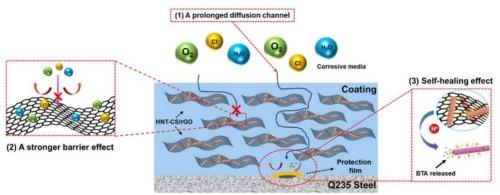基于高岭土纳米管/还原氧化石墨烯负载缓蚀剂的智能自修复涂层
IF 7.3
2区 材料科学
Q1 CHEMISTRY, APPLIED
引用次数: 0
摘要
在恶劣的海洋环境中,环氧树脂容易与纳米填料发生界面失配,导致防腐涂层快速失效。空心纳米管在高岭土纳米管中具有良好的热稳定性和结合能力,可以增强涂层的耐腐蚀性。本论文采用还原-混凝法将氧化石墨烯(GO)还原为还原型氧化石墨烯(rGO),并与高岭土纳米管(HNT)结合制成HNT/rGO,然后在HNT中负载缓蚀剂苯并三唑(BTA),包覆壳聚糖(CS),合成新型纳米填料HNT-CS/rGO。二维氧化石墨烯材料的引入不仅有效增强了涂层的被动阻隔能力,而且改善了填料与环氧树脂之间的界面相容性。在涂层的断裂韧性测试中,加入HNT/rGO填料的复合涂层的断裂韧性达到1368.78 J/m2,与纯环氧树脂涂层的586.14 J/m2相比有显著提高。添加2wt % HNT-CS/rGO的复合涂层在前28天的低频阻抗模式值超过1010 Ω.cm2,具有非常出色的防腐性能。同时,激光共聚焦扫描显微镜显示,在划痕处,含2 wt% HNT-CS/rGO的复合涂层的腐蚀性能明显优于纯环氧涂层,证明其具有良好的自愈性能。由此可见,HNT-CS/rGO改性环氧涂料具有优异的被动阻隔性能和主动修复性能,可有效抵抗恶劣的海洋环境,实现长期防腐。本文章由计算机程序翻译,如有差异,请以英文原文为准。

Smart self-healing coatings based on halloysite nanotube/reduced graphene oxide loaded with corrosion inhibitors
In the harsh marine environment, epoxy resin is prone to interface mismatch with nano-fillers, leading to rapid failure of anti-corrosion coatings. The excellent thermal stability and bonding ability of hollow nanotubes in halloysite nanotube can enhance the corrosion resistance of the coating. In this paper, graphene oxide (GO) was reduced to reduced graphene oxide (rGO) by reduction-coagulation method and combined with halloysite nanotube (HNT) to become HNT/rGO, then the novel nanofiller HNT-CS/rGO was synthesized by loading the corrosion inhibitor benzotriazole (BTA) in HNT and coating chitosan (CS). The introduction of 2D rGO material not only effectively strengthened the passive barrier ability of the coating, but also improved the interfacial compatibility between the filler and the epoxy resin. In the test of the fracture toughness of the coating, the fracture toughness of the composite coating with HNT/rGO filler reached 1368.78 J/m2, which was significantly increased compared with the 586.14 J/m2 of the pure epoxy resin coating. The low-frequency impedance mode value of the composite coating with 2 wt% HNT-CS/rGO added exceeded 1010 Ω.cm2 for the first 28 days, providing very excellent corrosion protection. Meanwhile, confocal laser scanning microscope showed that the composite coating with 2 wt% HNT-CS/rGO was significantly better than the pure epoxy coating in terms of corrosion at the scratch, which proved that it had a good self-healing performance. The above shows that HNT-CS/rGO modified epoxy coating has both excellent passive barrier and active repair performance, which can effectively resist the harsh marine environment and realize long-term corrosion protection.
求助全文
通过发布文献求助,成功后即可免费获取论文全文。
去求助
来源期刊

Progress in Organic Coatings
工程技术-材料科学:膜
CiteScore
11.40
自引率
15.20%
发文量
577
审稿时长
48 days
期刊介绍:
The aim of this international journal is to analyse and publicise the progress and current state of knowledge in the field of organic coatings and related materials. The Editors and the Editorial Board members will solicit both review and research papers from academic and industrial scientists who are actively engaged in research and development or, in the case of review papers, have extensive experience in the subject to be reviewed. Unsolicited manuscripts will be accepted if they meet the journal''s requirements. The journal publishes papers dealing with such subjects as:
• Chemical, physical and technological properties of organic coatings and related materials
• Problems and methods of preparation, manufacture and application of these materials
• Performance, testing and analysis.
 求助内容:
求助内容: 应助结果提醒方式:
应助结果提醒方式:


